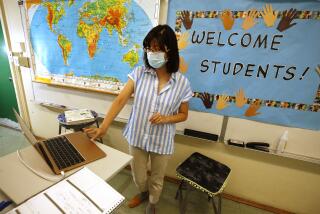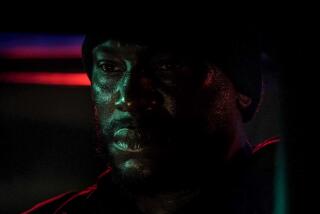When time allows, 1992 riots are poignant lesson in L.A. schools
They were not even born at the time their city erupted in flames, violence and rage against a system that would not convict Los Angeles police officers of brutally beating a black man.
But high school students Jiaya Ingram, Ashley Torres and Jessica Maldonado have been gripped by accounts of the 1992 Los Angeles riots as they learn about them through poetry and plays, readings and recollections of their parents and others.
They say they felt shock over police actions, horror over the mob violence and an uneasy feeling that it could happen again, particularly as unarmed African Americans are killed, most recently in Florida, Oklahoma and Pasadena. Yet these teenagers also express hope that they can make a difference through personal action — education about stereotypes, for instance, or peaceful protests.
“I’ve learned that you have to be the change you want to see in the world,” said Jessica, a junior at the Social Justice Leadership Academy, a small school at the Torres High School campus in East Los Angeles. “History is not wars and dates; it’s about the choices you make.”
But two decades after the riots sparked massive violence that would leave dozens dead and thousands injured, lessons about them appear to be limited in Southern California classrooms. For many teachers, the pressure to teach content that will be tested in state standardized tests and Advanced Placement exams next month has crowded out time for the riots, however crucial they are to city history and the nation’s larger civil rights struggle.
The Los Angeles Unified School District has not formally included the riots in its history curriculum because it is not part of the California social studies standards. The district plans to post material on its website for optional teacher use, however.
Michael Reed, the district’s history specialist, said the push to raise test scores has made principals “hawkish” about directing teachers to focus on the areas that will be tested. Test questions from the state’s eighth- and 11th-grade U.S. history exams released by state officials don’t stretch beyond the 1960s, although Reed said the latest tests included a question from the Nixon era of the 1970s.
“If students are taught what they will be held responsible for on tests, they do much better,” he said. “I remember teachers who would close their doors and teach whatever their pet era was. It’s fine, but California test scores go down the drain.”
At King Drew Medical Magnet High School, teachers focus on the 1965 Watts riots because the school was founded in part to prepare students for medical and scientific careers, a community need at the time. The school does not expect to cover the 1992 riots because of time constraints, according to Karl Graeber, the social studies department chairman.
Carson High School teacher Merri Weir also feels those pressures. But she manages to squeeze the riots into her U.S. history section on the move to the suburbs, exploring how redlining created the kind of ethnic ghetto that exploded after Simi Valley jurors chose not to convict four Los Angeles police officers in the beating of Rodney King. Her students create a memorial about the riots — one pair of students, for instance, constructed one from burned plywood to symbolize the vast destruction the violence caused.
“The riots and 1992 feel like a time period we can never get to because there are just not enough hours in the day,” she said. “But it’s really important for my students to learn about what happens when a community breaks down or has no hope and no sense of justice.”
Teachers who work at private, charter, magnet or other nontraditional campuses may have more flexibility.
Dorsey High School teacher Donald Singleton, for instance, is able to cover the riots as part of the school’s law magnet program. In his introduction to law class, he explores the King case as part of an examination of civil rights and related U.S. constitutional amendments.
Ninth-graders at Gertz-Ressler High School, a charter campus, are creating multimedia poetry and photography presentations about the riots in Crystal Greene’s elective English and math class.
Greene, like many teachers, uses materials from Facing History and Ourselves, an international educational organization that has trained more than 1,700 Los Angeles-area teachers in the last 17 years on how to teach about tolerance through case studies of the Holocaust, the Armenian genocide, the L.A. riots and the eugenics movement. The group, started in 1976, aims to present history not as an inevitable chain of events but as a series of choices by ordinary people that can produce great evil or tremendous good, according to Mary Hendra, the associate program director.
The group’s curriculum is used at such schools as St. John Chrysostom School in Inglewood. Through an assignment to interview their parents about the event, 13-year-old Nahom Seifu learned for the first time that his mother was caught in the streets with no transportation and survived the violence only because a stranger invited her to spend the night at her home.
At Crossroads School for Arts & Sciences in Santa Monica, seniors in Stephanie Carrillo’s elective class on cultural diversity are embodying those who lived through the riots by acting out the roles of African American victim, white juror, police officer, Korean immigrant and others from the play “Twilight: Los Angeles.” The play gives students multiple perspectives to help them understand the complex forces underlying the riots, Carrillo said.
Carrillo teaches the riots every year because, she said, they marked a watershed moment in her life. Then a college student two weeks from graduation, she said the King verdict shattered her faith in the justice system. But they also impassioned her to become a teacher to arm her students with the education to control their own lives, she said.
One of them is Jiaya. The Crossroads senior, the daughter of musician James Ingram, was raised in tony Hancock Park, but she said she identified with her “Twilight” character, an impoverished pregnant mother who was shot in the riots. She said she remains troubled by racism today.
To make change, she said she will push for educational seminars about stereotypes in her student leadership group in high school and, later, at college.
“I’m motivated to tell people how far we still need to go to live with true peace and no prejudice,” she said.
More to Read
Sign up for Essential California
The most important California stories and recommendations in your inbox every morning.
You may occasionally receive promotional content from the Los Angeles Times.











